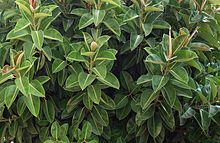Ficus elastica
| Rubber fig | |
|---|---|
 |
|
| Scientific classification | |
| Kingdom: | Plantae |
| (unranked): | Angiosperms |
| (unranked): | Eudicots |
| (unranked): | Rosids |
| Order: | Rosales |
| Family: | Moraceae |
| Tribe: | Ficeae |
| Genus: | Ficus |
| Subgenus: | Urostigma |
| Species: | F. elastica |
| Binomial name | |
|
Ficus elastica Roxb. ex Hornem. 1819 not Roxb. 1832 nor Roxb. 1814 (the last one not validly published) |
|
| Synonyms | |
|
|
Ficus elastica, the rubber fig, rubber bush, rubber tree, rubber plant, or Indian rubber bush, is a species of plant in the fig genus, native to northeast India, Nepal, Bhutan, Burma, China (Yunnan), Malaysia, and Indonesia. It has become naturalized in Sri Lanka, the West Indies, and the US State of Florida.
It is a large tree in the banyan group of figs, growing to 30–40 metres (98–131 ft) (rarely up to 60 metres or 200 feet) tall, with a stout trunk up to 2 metres (6.6 ft) in diameter. The trunk develops aerial and buttressing roots to anchor it in the soil and help support heavy branches. It has broad shiny oval leaves 10–35 centimetres (3.9–13.8 in) long and 5–15 centimetres (2.0–5.9 in) broad; leaf size is largest on young plants (occasionally to 45 centimetres or 18 inches long), much smaller on old trees (typically 10 centimetres or 3.9 inches long). The leaves develop inside a sheath at the apical meristem, which grows larger as the new leaf develops. When it is mature, it unfurls and the sheath drops off the plant. Inside the new leaf, another immature leaf is waiting to develop.
As with other members of the genus Ficus, the flowers require a particular species of fig wasp to pollinate it in a co-evolved relationship. Because of this relationship, the rubber plant does not produce highly colourful or fragrant flowers to attract other pollinators. The fruit is a small yellow-green oval fig 1 centimetre (0.39 in) long, barely edible; it will only contain viable seed where the relevant fig wasp species is present.
...
Wikipedia
